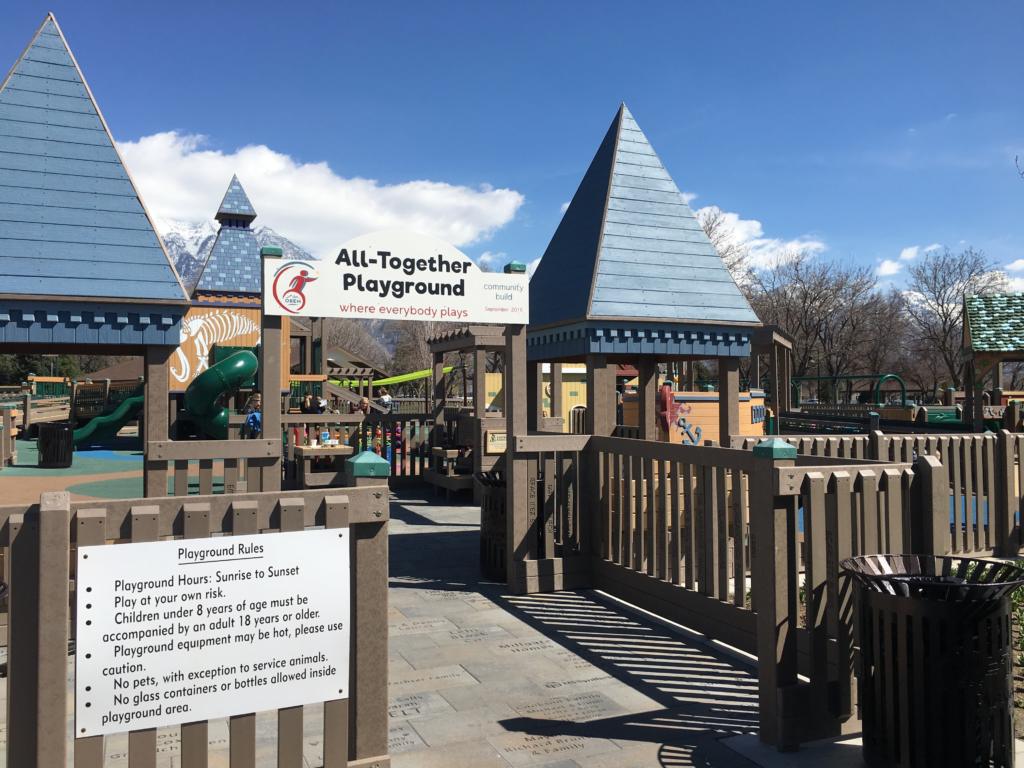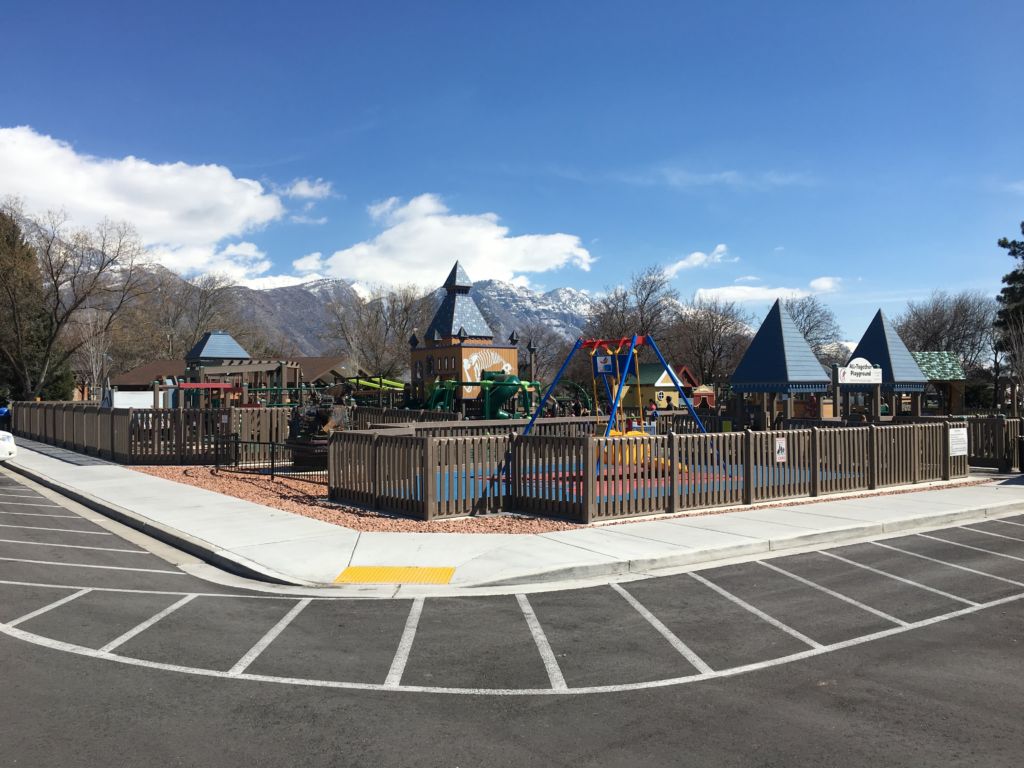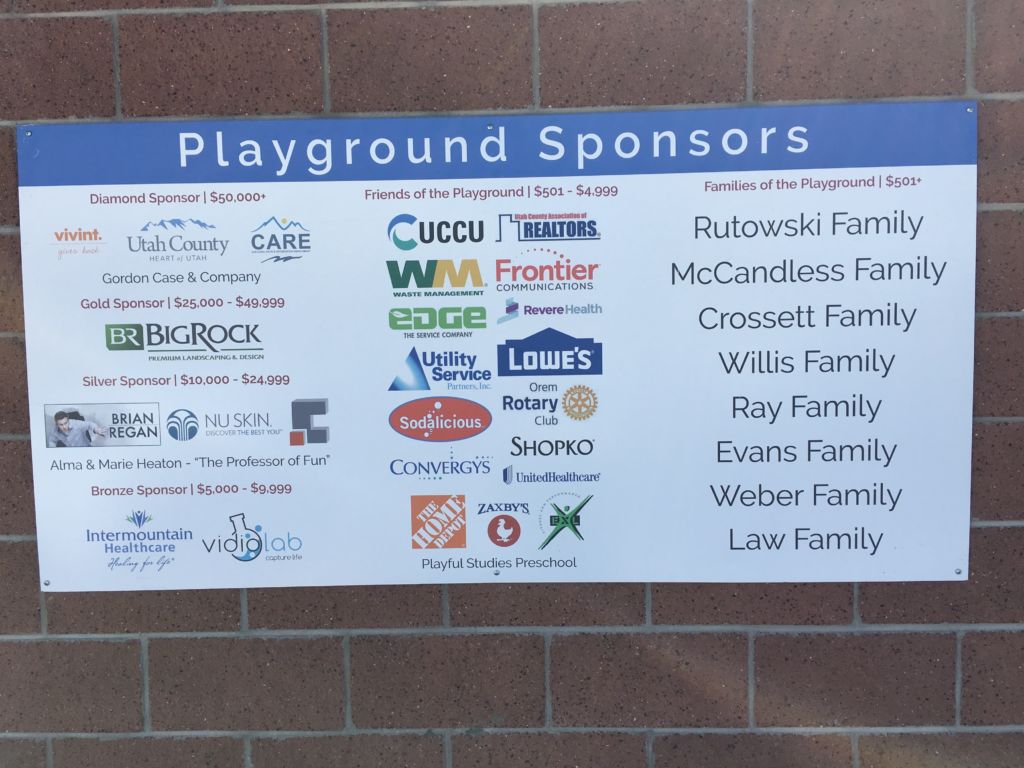 The All Together Playground in Orem, Utah, is the first of its kind in Utah County, and on the crest of a movement to make play accessible to all children. This all-abilities playground provides children with disabilities a way to play alongside their peers, and the playground’s story began when the city sought public input about making recreational improvements.
The All Together Playground in Orem, Utah, is the first of its kind in Utah County, and on the crest of a movement to make play accessible to all children. This all-abilities playground provides children with disabilities a way to play alongside their peers, and the playground’s story began when the city sought public input about making recreational improvements.
“We reached out through social media to find out what the needs and wants were in the community,” Steve Downs, Orem deputy city manager, said.
Two mothers, Katrina Bleyl and Mindy Gleason, whose daughters used wheelchairs, suggested an all-abilities playground.
“They didn’t have a local place to play,” Downs said. “They had to go to Salt Lake City to play [at an all-abilities playground].”
Bleyl and Gleason hoped for a wheelchair accessible swing set, but the city committed to an entire playground, at an estimated cost of $.2 million. The city pledged $350,000, and the community rallied to raise the funds needed for the playground and local businesses donated materials and labor.
“Just knowing that it wouldn’t just affect (my daughter), but knowing that it would affect other kids in the area, and not just Orem,” Bleyl told the Daily Universe. “It just builds awareness and kindness, and all sorts of good stuff.”
As city officials began to work with the community to plan the park, they reached out to local elementary school pupils, asking them what they wanted in a park, while considering the needs of children of all abilities and Orem’s unique history.
Children asked for – and received – a pirate ship, space ship and castle, and Orem’s past is represented with a clock tower, train and mammoth-themed slide. Utah’s mountain peaks are invoked by the playground’s design, particularly nearby Mount Timpanogos. James C. Christensen, an award-winning artist, author and Orem resident, created a one-of-a-kind mural for the playground.
“He actually just passed from cancer – he was going through that, and he spent some of his final days painting for us,” Downs said.
Most importantly, those planning the park listened to families with children impacted with mobility and neurological issues. One of the items included a fence around the playground to keep children on the autism spectrum safe.
“Some of them are runners, and parents were worried they could run into the parking lot or the street,” Downs said. “They wanted some type of protection, a border between the parking lot and the playground.”
Other considerations include switching to a soft rubber matting instead of a mulch that could cause issues for those children with mobility or sensory issues, making the walkways wide enough to accommodate wheelchairs and including ramps instead of stairs.
“We wanted everything to be without barriers,” Downs said. “There are no stairs; we have ramps the whole way up to the highest point. There isn’t anywhere they can’t go.”
One of the primary pushes was to design a playground that would be attractive to all children while allowing children of all abilities to play side-by-side with their peers.
To encourage cooperative play, games such as the NEOS 360 – an interactive game system that improves auditory and spatial awareness and peripheral vision – were incorporated. The playground also features zip lines with chairs alongside traditional set ups so children of all abilities can race one another.
“One of the big pushes is to allow children with disabilities to socialize with their peers,” Downs said. “This playground allows them to do the same activities beside their friends.”
When the community was called upon for volunteers to build the playground, more than 4,000 showed up – almost a thousand more than city leaders had asked for, and Habitat for Humanity donated the tools used to build the playground. A local Boy Scout, Leo Parcell, made 50 sawhorses for the playground’s construction, and volunteers worked from sunup to sundown for seven straight days.
“All of them took time away from work and family to build this for our children,” Downs said.
The Daily Herald wrote an editorial praising the effort, noting “Many local children suffer from physical disabilities, while many others fall on the autism spectrum. Traditional playgrounds oftentimes are not equipped to provide the same play experience for children who must use wheelchairs or walkers or who deal with certain sensory issues.

“There are a handful of nonprofit organizations that have recognized this, and have created all-ability facilities for the use of their own patients and clients. Now, thankfully, we have a local city stepping forward and recognizing the need for a public space that offers those same benefits.”
Downs was moved by watching Brinley Bleyl play in the park shortly after completion of the all-ability playground.
“She got behind the wheel [of the pirate ship], she was giving orders and you could see that she knew what she wanted to do,” he said. “She was participating in imaginative role play and she had a story for the ship. She’s always had this imagination, but she couldn’t express it this way before. And we were able to take away that physical barrier.”
“Play is called the work of children. We believe that children of all abilities deserve an opportunity to play,” Orem Mayor Richard Brunst told Utah Valley 360. “That’s what this playground is all about. Families, individuals, college students, city staff, businesses and residents have all volunteered time and money to help build this great and beautiful playground with love. All people need to feel love. I hope that all the love that has been put into this park will be a reminder to the children who play here how much we love and appreciate them.”
Downs noted the city encourages the local school district to utilize the park, especially those classes that include children with mobility issues or who are neurodiverse and he enjoys driving past the park and seeing school buses in the parking lot. “This playground was founded in the minds of our young children and built by their parents and neighbors,” Downs said. “At the end of the day, the community built this for their kids, their neighbors and their friends’ kids.”
“This playground was founded in the minds of our young children and built by their parents and neighbors,” Downs said. “At the end of the day, the community built this for their kids, their neighbors and their friends’ kids.”
Utility Service Partners, now known as the NLC Service Line Warranty Program by HomeServe (NLC SLWP), was one of the all-ability playground sponsors. NLC SLWP provides emergency repair warranties and education on service line responsibilities at no cost to cities. Qualifying cities can receive royalties that can go toward similar and other programs and needs. For information on how the Service Line Warranty Program can benefit your community, contact us.

